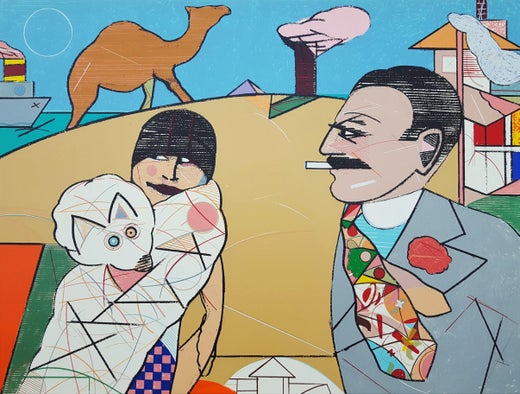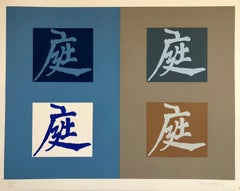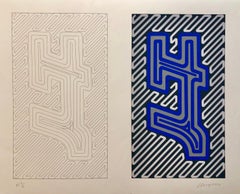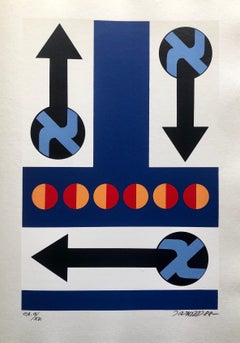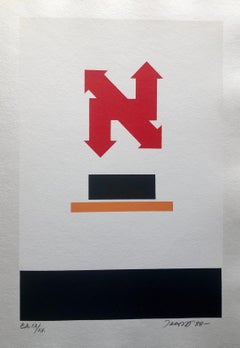Want more images or videos?
Request additional images or videos from the seller
1 of 8
Richard MerkinPrince Valiant Pop Art 1969 Color Screenprint Richard Merkin1969
1969
$750List Price
About the Item
- Creator:Richard Merkin (1938 - 2009, American)
- Creation Year:1969
- Dimensions:Height: 26 in (66.04 cm)Width: 20 in (50.8 cm)
- Medium:
- Movement & Style:
- Period:
- Condition:
- Gallery Location:Surfside, FL
- Reference Number:1stDibs: LU38211138712
Richard Merkin
Richard Merkin’s (1938 – September 5, 2009) work conjures up scenes that evoke the raucous spirit of the 1920’s, 30’s and 40’s. In his witty, often eccentric illustrations, Merkin depicts movie stars, jazz musicians, sports heroes and literary impresarios co-mingling with more personal references. In his highly stylized approach to the figure, Merkin privileges color relationships, balance and juxtaposition over strictly literal descriptions of his subjects. And humor; there’s always humor.
About the Seller
4.9
Platinum Seller
Premium sellers with a 4.7+ rating and 24-hour response times
Established in 1995
1stDibs seller since 2014
1,833 sales on 1stDibs
Typical response time: 1 hour
Authenticity Guarantee
In the unlikely event there’s an issue with an item’s authenticity, contact us within 1 year for a full refund. DetailsMoney-Back Guarantee
If your item is not as described, is damaged in transit, or does not arrive, contact us within 7 days for a full refund. Details24-Hour Cancellation
You have a 24-hour grace period in which to reconsider your purchase, with no questions asked.Vetted Professional Sellers
Our world-class sellers must adhere to strict standards for service and quality, maintaining the integrity of our listings.Price-Match Guarantee
If you find that a seller listed the same item for a lower price elsewhere, we’ll match it.Trusted Global Delivery
Our best-in-class carrier network provides specialized shipping options worldwide, including custom delivery.You May Also Like
Steve Kaufman "Abraham Lincoln" 1990 Artist Proof Serigraph, Hand Signed Verso
By Steve Kaufman
Located in Miami, FL
STEVE KAUFMAN – "ABRAHAM LINCOLN"
⚜ Serigraph on Canvas ⚜ Initialed Verso ⚜ Edition 48/50 AP ⚜ Black Float Frame
VIBRANT POP ICONOGRAPHY OF AN AMERICAN LEGEND
This bold 1990 serigra...
Category
1990s Pop Art Abstract Prints
Materials
Screen, Canvas
$3,200
H 19.5 in W 15.125 in D 2 in
Deslumbramiento
By Luis Gordillo
Located in Mexico City, MX
The work of Luis Gordillo spans more than five decades. He began his career by developing a new pictorial language that became a point of reference for an entire generation of artist...
Category
20th Century Pop Art Abstract Prints
Materials
Screen
Archipiélago dinámico
By Luis Gordillo
Located in Mexico City, MX
The work of Luis Gordillo spans more than five decades. He began his career by developing a new pictorial language that became a point of reference for an entire generation of artist...
Category
20th Century Pop Art Abstract Prints
Materials
Screen
"Nobility" 180/300 Signed Color Serigraph of Abstract Horse and Woman with Lute
By Tiefeng Jiang
Located in Austin, TX
Serigraph on paper
Page Size: 12 x 12 in.
Gold Leaf Frame Size: 21 x 21 in.
Hand Signed, bottom right in black marker
Hand Numbered, bottom left in black marker "180/300"
This strik...
Category
1990s Pop Art Animal Prints
Materials
Archival Paper, Screen
Bags
Located in Santa Monica, CA
Silkscreen/Collage on Retail Bags
Category
21st Century and Contemporary Pop Art Mixed Media
Materials
Screen
Man Powered Airplane Solomon (Jun Rope)
By Yokoo Tadanori
Located in New York, NY
Tadanori Yokoo
Man Powered Airplane Solomon (Jun Rope), 1967
Silkscreen poster
41 x 29 inches (image)
44 1/4 x 32 1/2 x 1 1/2 inches (frame)
Signed and stamped with Artist's seal
Wh...
Category
1970s Pop Art Abstract Prints
Materials
Screen
"New York City Center 25th Anniversary"
By Robert Indiana
Located in New York, NY
Robert Indiana
"New York City Center 25th Anniversary"
New York City Center, 1968
Silkscreen Poster
35 x 25 inches
Unsigned
This poster is printed on...
Category
1960s Pop Art Abstract Prints
Materials
Screen
Louisiana Museum of Modern Art (LOVE) Poster /// Robert Indiana Pop Art Blue Red
By Robert Indiana
Located in Saint Augustine, FL
Artist: (after) Robert Indiana (American, 1928-2018)
Title: "Louisiana Museum of Modern Art (LOVE)"
Year: 1972 (First edition)
Medium: Original Screenprint, Exhibition Poster on heav...
Category
1970s Pop Art Abstract Prints
Materials
Screen
$1,200
H 33.5 in W 24.5 in
Vintage Mona Lisa
By Mr. Brainwash
Located in New York, NY
Vintage Mona Lisa, 2020
Signed and numbered in pencil with thumbprint in verso
Silkscreen
22.5 x 30 inches
Edition 15 of 35
Category
2010s Pop Art Abstract Prints
Materials
Screen
The Calumet /// Pop Art Robert Indiana Native American Indiana Screenprint Red
By Robert Indiana
Located in Saint Augustine, FL
Artist: Robert Indiana (American, 1928-2018)
Title: "The Calumet"
Portfolio: The American Dream
*Issued unsigned
Year: 1997
Medium: Original Screenprint on Coventry paper
Limited edition: 395, (there were also 30 artist's proofs)
Printer: Marco Fine Arts Contemporary Atelier, El Segundo, CA
Publisher: Marco Fine Arts Contemporary Atelier, El Segundo, CA
Sheet size: 22" x 16.75"
Image size: 15.07" x 14"
Condition: In excellent condition
Notes:
Provenance: private collection - Düsseldorf, Germany. Comes from Indiana's 1997 "The American Dream" book portfolio of thirty screenprints. Printed in three colors. Text on verso of the following work as issued.
Robert Indiana's 1997 black leather-covered book portfolio "The American Dream" was printed and published with 30 screenprints: 6 loose each signed and numbered and 24 bound not signed and numbered, as issued. Forward by Susan Ryan, text by Michael McKenzie and poems by Robert Creeley. The book was issued within a white cardboard packing box with red and black lettering.
This image is based of Indiana's 1971 screenprint edition "The Calumet", (Sheehan No. 64, page 43), from his 1971 "Decade" series, (Sheehan No. 63-72, page 42-44). The prints in that portfolio reproduce one of Indiana's paintings from each year of the 1960's. The bear they same titles as the corresponding paintings. "The Calumet" is a 1961, 90" x 84", oil on canvas painting which is within the permanent collection of the Rose Art Museum, Brandeis University, Waltham, MA.
"The Calumet", derived from Longfellow's "Song of Hiawatha", reflects Indiana's ongoing involvement with American literary associations and sources. As interpreted, by Indiana, the schematized image of the red clay peace-pipe smoked by the Indians in Longfellow's poem symbolizes mankind's potential to eradicate war. - (Sheehan page 9). Seven stars for seven spheres...
Category
1990s Pop Art Abstract Prints
Materials
Screen
More From This Seller
View All1980's Large Silkscreen Chinese Characters Serigraph Pop Art Print China
By Chryssa Vardea-Mavromichali
Located in Surfside, FL
Chryssa Vardea-Mavromichali (Greek: Χρύσα Βαρδέα-Μαυρομιχάλη; December 31, 1933 – December 23, 2013) was a Greek American artist who worked in a wide variety of media. An American art pioneer in light art and luminist sculpture widely known for her neon, steel, aluminum and acrylic glass installations, she has always used the mononym Chryssa professionally. She worked from the mid-1950s in New York City studios and worked since 1992 in the studio she established in Neos Kosmos, Athens, Greece.
Chryssa was born in Athens into the famous Mavromichalis family from the Mani Peninsula. one of her sisters, who studied medicine, was a friend of the poet and novelist Nikos Kazantzakis.
Chryssa began painting during her teenage years and also studied to be a social worker.In 1953, on the advice of a Greek art critic, her family sent her to Paris to study at the Académie de la Grande Chaumiere where Andre Breton, Edgard Varese, and Max Ernst were among her associates and Alberto Giacometti was a visiting professor.
In 1954, at age twenty-one, Chryssa sailed for the United States, arrived in New York and went to San Francisco, California to study at the California School of Fine Arts. Returning to New York in 1955, she became a United States citizen and established a studio in the city.
Chryssa's first major work was The Cycladic Books preceded American minimalism by seventeen years.
1961, Chryssa's first solo exhibition was mounted at The Guggenheim.
1963, Chryssa's work was shown at the Museum of Modern Art in curator Dorothy Canning Miller's Americans 1963 exhibition. The artists represented in the show also included Richard Anuszkiewicz, Lee Bontecou, Robert Indiana, Richard Lindner, Marisol, Claes Oldenburg, Ad Reinhardt, James Rosenquist and others.
1966, The Gates to Times Square, regarded as "one of the most important American sculptures of all time" and "a thrilling homage to the living American culture of advertising and mass communications." The work is a 10 ft cube installation of two huge letter 'A's through which visitors may walk into "a gleaming block of stainless steel and Plexiglas that seems to quiver in the play of pale blue neon light" which is controlled by programmed timers. First shown in Manhattan's Pace Gallery, it was given to the Albright-Knox Art Gallery in Buffalo, New York in 1972.
1972, The Whitney Museum of American Art mounted a solo exhibition of works by Chryssa.
That's All (early 1970s), the central panel of a triptych related to The Gates of Times Square, was acquired by the Museum of Modern Art between 1975 and 1979.
1973, Chryssa's solo exhibition at the Gallerie Denise René was reviewed for TIME magazine by art critic Robert Hughes before it went on to the Galleries Denise René in Düsseldorf and Paris.
Other works by Chryssa in composite honeycomb aluminum and neon in the 1980s and 1990s include Chinatown, Siren, Urban Traffic, and Flapping Birds.
Chryssa 60/90 retrospective exhibition in Athens in the Mihalarias Art Center. After her long absence from Greece, a major exhibition including large aluminum sculptures - cityscapes, "neon boxes" from the Gates to the Times Square, paintings, drawings etc. was held in Athens.
In 1992, after closing her SoHo studio, which art dealer Leo Castelli had described as "one of the loveliest in the world," Chryssa returned to Greece. She found a derelict cinema which had become a storeroom stacked with abandoned school desks and chairs, behind the old Fix Brewery near the city center in Neos Kosmos, Athens. Using the desks to construct enormous benches, she converted the space into a studio for working on designs and aluminum composite honeycomb sculptures. The Athens National Museum of Contemporary Art, which was founded in 2000 and owns Chryssa's Cycladic Books, is in the process of converting the Fix Brewery into its permanent premises.
Greek Exhibits, European Cultural Center of Delphi (Council of Europe). "Apollo's Heritage"(July 4, 2003 – July 30, 2003). Works by sixteen artists: Giorgio de Chirico, Salvador Dalí, Nikos Hadjikyriakos-Ghikas, Nikos Engonopoulos, Yannis Tsarouchis, Giorgos Sikeliotis, Takis, Arman, Fernando Botero, Chryssa, Dimitris Mytaras...
Category
1980s Pop Art Abstract Prints
Materials
Screen
1970's Large Silkscreen Abstract Geometric Day Glo Serigraph Pop Art Print Neon
By Chryssa Vardea-Mavromichali
Located in Surfside, FL
Silkscreen on Arches paper, Hand signed and Numbered in Pencil. Serigraph in white, back, blue gray (silver).
Chryssa Vardea-Mavromichali (Greek: Χρύσα Βαρδέα-Μαυρομιχάλη; December 31, 1933 – December 23, 2013) was a Greek American artist who worked in a wide variety of media. An American art pioneer in light art and luminist sculpture widely known for her neon, steel, aluminum and acrylic glass installations, she has always used the mononym Chryssa professionally. She worked from the mid-1950s in New York City studios and worked since 1992 in the studio she established in Neos Kosmos, Athens, Greece.
Chryssa was born in Athens into the famous Mavromichalis family from the Mani Peninsula. one of her sisters, who studied medicine, was a friend of the poet and novelist Nikos Kazantzakis.
Chryssa began painting during her teenage years and also studied to be a social worker.In 1953, on the advice of a Greek art critic, her family sent her to Paris to study at the Académie de la Grande Chaumiere where Andre Breton, Edgard Varese, and Max Ernst were among her associates and Alberto Giacometti was a visiting professor.
In 1954, at age twenty-one, Chryssa sailed for the United States, arrived in New York and went to San Francisco, California to study at the California School of Fine Arts. Returning to New York in 1955, she became a United States citizen and established a studio in the city.
Chryssa's first major work was The Cycladic Books preceded American minimalism by seventeen years.
1961, Chryssa's first solo exhibition was mounted at The Guggenheim.
1963, Chryssa's work was shown at the Museum of Modern Art in curator Dorothy Canning Miller's Americans 1963 exhibition. The artists represented in the show also included Richard Anuszkiewicz, Lee Bontecou, Robert Indiana, Richard Lindner, Marisol, Claes Oldenburg, Ad Reinhardt, James Rosenquist and others.
1966, The Gates to Times Square, regarded as "one of the most important American sculptures of all time" and "a thrilling homage to the living American culture of advertising and mass communications." The work is a 10 ft cube installation of two huge letter 'A's through which visitors may walk into "a gleaming block of stainless steel and Plexiglas that seems to quiver in the play of pale blue neon light" which is controlled by programmed timers. First shown in Manhattan's Pace Gallery, it was given to the Albright-Knox Art Gallery in Buffalo, New York in 1972.
1972, The Whitney Museum of American Art mounted a solo exhibition of works by Chryssa.
That's All (early 1970s), the central panel of a triptych related to The Gates of Times Square, was acquired by the Museum of Modern Art between 1975 and 1979.
1973, Chryssa's solo exhibition at the Gallerie Denise René was reviewed for TIME magazine by art critic Robert Hughes before it went on to the Galleries Denise René in Düsseldorf and Paris.
Other works by Chryssa in composite honeycomb aluminum and neon in the 1980s and 1990s include Chinatown, Siren, Urban Traffic, and Flapping Birds.
Chryssa 60/90 retrospective exhibition in Athens in the Mihalarias Art Center. After her long absence from Greece, a major exhibition including large aluminum sculptures - cityscapes, "neon boxes" from the Gates to the Times Square, paintings, drawings etc. was held in Athens.
In 1992, after closing her SoHo studio, which art dealer Leo Castelli had described as "one of the loveliest in the world," Chryssa returned to Greece. She found a derelict cinema which had become a storeroom stacked with abandoned school desks and chairs, behind the old Fix Brewery near the city center in Neos Kosmos, Athens. Using the desks to construct enormous benches, she converted the space into a studio for working on designs and aluminum composite honeycomb sculptures...
Category
1980s Pop Art Abstract Prints
Materials
Screen
Hungarian Surrealism Pop Art Hebrew Silkscreen Judaica Print Jewish Serigraph
By Jozsef Jakovits
Located in Surfside, FL
Abstract Hebrew Prints on heavy mould made paper from small edition of 15. there is a facing page of text in Hungarian folded over. Hard edged geometric abstract prints in color base...
Category
1980s Pop Art Abstract Prints
Materials
Archival Paper, Screen
Surrealist Abstract Hebrew Aleph Pop Art Silkscreen Judaica Jewish Serigraph
By Jozsef Jakovits
Located in Surfside, FL
Abstract Hebrew Prints on heavy mould made paper from small edition of 15. there is a facing page of text in Hungarian folded over. Hard edged geometric abstract prints in color base...
Category
1980s Pop Art Abstract Prints
Materials
Archival Paper, Screen
Surrealist Abstract Hebrew Shabbat Pop Art Silkscreen Judaica Jewish Serigraph
By Jozsef Jakovits
Located in Surfside, FL
Abstract Hebrew Prints on heavy mould made paper from small edition of 15. there is a facing page of text in Hungarian folded over. Hard edged geometric abstract prints in color base...
Category
1980s Pop Art Abstract Prints
Materials
Archival Paper, Screen
Pop Art Aspen Road Sign D'arcangelo Silkscreen Chiron Press Vintage Art Poster
Located in Surfside, FL
Allan D'Arcangelo (American/New York, 1930-1998),
"Aspen Center of Contemporary Art",
1967
silkscreen, hand signed in pencil, dated, numbered "45/200" and blind stamped "Chiron Press, New York, NY"
32 in. x 24 in.
Allan D'Arcangelo (1930-1998) was an American artist and printmaker, best known for his paintings of highways and road signs that border on pop art and minimalism, precisionism, Abstract illusionism and hard-edge painting, and also surrealism. His subject matter is distinctly American and evokes, at times, a cautious outlook on the future of this country. Allan D'Arcangelo was the son of Italian immigrants. He studied at the University of Buffalo from 1948–1953, where he got his bachelor's degree in history. After college, he moved to Manhattan and picked up his studies again at the New School of Social Research and the City University of New York, City College. At this time, he encountered Abstract Expressionist painters who were in vogue at the moment. After joining the army in the mid 1950s, he used the GI Bill to study painting at Mexico City College from 1957–59, driving there over 12 days in an old bakery truck retrofitted as a camper. However, he returned to New York in 1959, in search of the unique American experience. It was at this time that his painting took on a cool sensibility reminiscent of Roy Lichtenstein and Andy Warhol. His interests engaged with the environment, anti-Vietnam War protests, and the commodification and objectification of female sexuality. D'Arcangelo first achieved recognition in 1962, when he was invited to contribute an etching to The International Anthology of Contemporary Engraving: America Discovered; his first solo exhibition came the next year, at the Thiebaud Gallery in New York City. In 1965 he contributed three screenprints to Original Edition's 11 Pop Artists portfolio. By the 1970s, D'Arcangelo had received significant recognition in the art world. He was well known for his paintings of quintessentially American highways and infrastructure, and in 1971 was commissioned by the Department of the Interior to paint the Grand Coulee Dam in Washington state. However, his sense of morality always trumped his interest in art world fame. In 1975, he decided to quit the gallery that had been representing him for years, Marlborough Gallery, because of the way they handled Mark Rothko legacy.
D'Arcangelo rejected Abstract Expressionism, though his early work has a painterly and somewhat expressive feel. He quickly turned to a style of art that seemed to border on Pop Art and Minimalism, Precisionism and Hard-Edge painting. Evidently, he didn't fit neatly in the category of Pop Art, though he shared subjects (women, signs, Superman) and techniques (stencil, assemblage) with these artists.He turned to expansive, if detached scenes of the American highway. These paintings are reminiscent of Giorgio de Chirico-though perhaps not as interested in isolation-and Salvador Dali-though there is a stronger interest in the present and disinterest in the past. These paintings also have a sharp quality that is reminiscent of the precisionist style, or more specifically, Charles Sheeler. 1950s, Before D'Arcangelo returned to New York, his style was roughly figurative and reminiscent of folk art. During the early 1960s, Allan D'Arcangelo was linked with Pop Art. "Marilyn" (1962) depicts an illustrative head and shoulders on which the facial features are marked by lettered slits to be "fitted" with the eyebrows, eyes, nose and mouth which appear off to the right in the composition. In "Madonna and Child," (1963) the featureless faces of Jackie Kennedy and Caroline are ringed with haloes, enough to make their status as contemporary icons perfectly clear.
Select Exhibitions:
Fischbach Gallery, New York,
Ileana Sonnabend Gallery, Paris,
Gallery Müller, Stuttgart, Germany
Hans Neuendorf Gallery, Hamburg, Germany
Dwan Gallery...
Category
1960s Pop Art Abstract Prints
Materials
Lithograph, Screen
